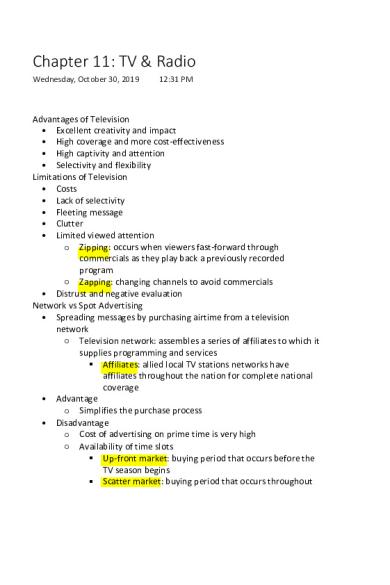Chapter 11 TV & Radio - Professor Cauley PDF

| Title | Chapter 11 TV & Radio - Professor Cauley |
|---|---|
| Author | Skylar Asmar |
| Course | Promotional Strategy |
| Institution | Clemson University |
| Pages | 3 |
| File Size | 76.8 KB |
| File Type | |
| Total Downloads | 26 |
| Total Views | 182 |
Summary
Professor Cauley ...
Description
Chapter 11: TV & Radio Wednesday, October 30, 2019
12:31 PM
Advantages of Television • Excellent creativity and impact • High coverage and more cost-effectiveness • High captivity and attention • Selectivity and flexibility Limitations of Television • Costs • Lack of selectivity • Fleeting message • Clutter • Limited viewed attention ○ Zipping: occurs when viewers fast-forward through commercials as they play back a previously recorded program ○ Zapping: changing channels to avoid commercials • Distrust and negative evaluation Network vs Spot Advertising • Spreading messages by purchasing airtime from a television network ○ Television network: assembles a series of affiliates to which it supplies programming and services § Affiliates: allied local TV stations networks have affiliates throughout the nation for complete national coverage • Advantage ○ Simplifies the purchase process • Disadvantage ○ Cost of advertising on prime time is very high ○ Availability of time slots § Up-front market: buying period that occurs before the TV season begins § Scatter market: buying period that occurs throughout
the season • Spot advertising: commercials shown on local TV stations ○ Time is negotiated and purchased directly from the individual stations • National spot advertising: nonnetwork advertising done by a national advertiser • Local advertising: airtime sold to local firms Syndication • Syndicated programs: sold and distributed station by station • 3 types ○ Off-network syndication are "reruns" ○ First-run syndications are also featured ○ Advertiser-supported or bartered § Shows are sold to stations in return for a portion of the commercial time in the show § Offers both off-network and first-run syndicated programs Methods of Buying Time: Sponsorship "Hallmark", Ford, AT&T, IBM • Advertiser assumes responsibility for the production and content of the program and the advertising that appears within it • Allows a firm to: ○ Capitalize on the prestige of a high quality program ○ Have more control over the shows carrying their commercials • Several advertisers buying commercial time on a particular program • Advantages ○ Advertiser has no long-term commitment to a program ○ Expenditures can be adjusted to buy spots that fit within the budget ○ Provide greater reach in the media schedule • Disadvantages ○ Advertiser has little control over the placement of ads ○ Availability of spots can be an issue • Selecting time periods and programs ○ Cost of advertising time varies depending on the: § Time of day § Particular program
TV time periods are divided into dayparts § Dayparts: specific segments of a broadcast day § Advertising rates depend on the size and popularity of dayparts Advantages of Radio • Cost and efficiency • Receptivity • Selectivity • Flexibility • Mental imagery ○ Image transfer: images of a TV commercial are implanted into a radio spot • Integrated marketing opportunities Limitations of Radio • Creative limitations • Fragmentation • Chaotic buying procedures • Limited research data • Limited listener attention • Competition from digital media Buying Radio Time • Network radio: purchased on a network basis using one of the national networks • Spot radio provides: ○ Greater flexibility in selecting markets ○ Individual stations ○ Airtime and a chance to adjust the message for local market conditions • Local radio: purchased from individual stations by local companies ○...
Similar Free PDFs

Sejarah Dunia Peyiaran TV & Radio
- 25 Pages

11-18 - Professor Hunter
- 4 Pages

TV
- 27 Pages

Radio
- 18 Pages

11-9-17 network tv diversity
- 6 Pages

Radio
- 2 Pages

CL 11 - Professor: Sarah Wells
- 2 Pages

FS-11 SP18 - Professor Bolten
- 63 Pages

TV Genre
- 4 Pages

Ch-11 - Chapter 11
- 11 Pages
Popular Institutions
- Tinajero National High School - Annex
- Politeknik Caltex Riau
- Yokohama City University
- SGT University
- University of Al-Qadisiyah
- Divine Word College of Vigan
- Techniek College Rotterdam
- Universidade de Santiago
- Universiti Teknologi MARA Cawangan Johor Kampus Pasir Gudang
- Poltekkes Kemenkes Yogyakarta
- Baguio City National High School
- Colegio san marcos
- preparatoria uno
- Centro de Bachillerato Tecnológico Industrial y de Servicios No. 107
- Dalian Maritime University
- Quang Trung Secondary School
- Colegio Tecnológico en Informática
- Corporación Regional de Educación Superior
- Grupo CEDVA
- Dar Al Uloom University
- Centro de Estudios Preuniversitarios de la Universidad Nacional de Ingeniería
- 上智大学
- Aakash International School, Nuna Majara
- San Felipe Neri Catholic School
- Kang Chiao International School - New Taipei City
- Misamis Occidental National High School
- Institución Educativa Escuela Normal Juan Ladrilleros
- Kolehiyo ng Pantukan
- Batanes State College
- Instituto Continental
- Sekolah Menengah Kejuruan Kesehatan Kaltara (Tarakan)
- Colegio de La Inmaculada Concepcion - Cebu





